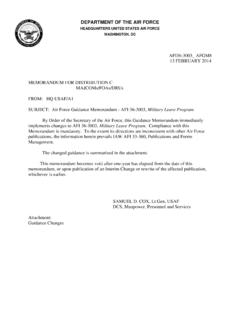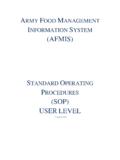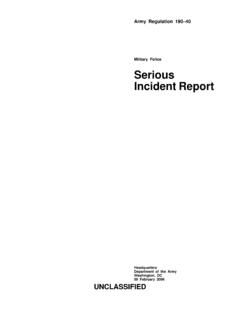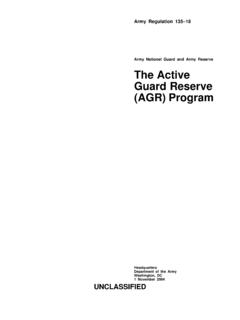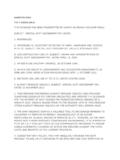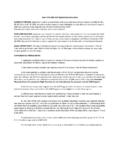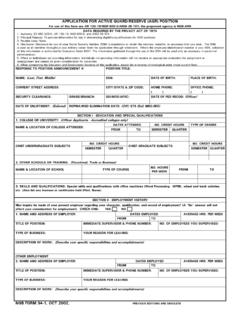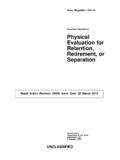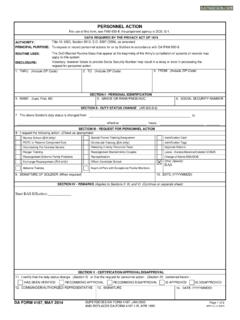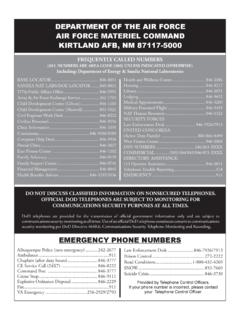Transcription of The Air Force Suicide Prevention Program
1 TheAir ForceSuicidePreventionProgramA description ofprogram initiativesand outcomesA description ofprogram initiativesand outcomesApril 2001 April 2001 AFPAM 44-1602US AIR Force Suicide Prevention PROGRAMOPR: AFMOA/SGZP (Lt Col G. Wayne Talcott)Certified by: AFMOA/CV(Col Paul B. Christianson)Pages: 54 Distribution: F3US AIR Force Suicide Prevention PROGRAMMICHAEL E. RYANGENERAL, USAFCHIEF OF STAFFPAUL K. CARLTON, GENERAL, USAFSURGEON GENERALPREFACEThe United States Air Force is committed to maintaining a fit and healthyforce because the health of the Air Force community is crucial to Force readiness. In1996, the Vice Chief of Staff directed the establishment of an integrated product team(IPT) dedicated to reducing the number of lives lost to Suicide .
2 With senior leader-ship support, the IPT developed a plan that marked the inception of the Air ForceSuicide Prevention its creation, Suicide rates among Air Force members have fallen torecord lows. We commend the hard work and dedication of those personnel in-volved in the development of the Suicide Prevention Program . Toward that end, thisdocument recounts their Air Force Suicide Prevention Program has heightened community aware-ness of Suicide and Suicide risk factors. In addition, it has created a safety net thatprovides protection and adds support for those in trouble. As we move beyondprogram development and implementation, we must work to sustain the effort. AirForce leadership should continually strive to communicate in words and actions thatit is not only acceptable, but also a sign of strength, to recognize life problems and toget the necessary help.
3 As the Program matures, it will require continued leadershipsupport and involvement in addressing the needs of Air Force members. Our workis not done. We are fully committed to the Air Force Suicide Prevention Program now and in the AIR Force Suicide Prevention PROGRAM5US AIR Force Suicide Prevention PROGRAMTABLE OF 7 ILEADERSHIP 9II ADDRESSING Suicide THROUGH PROFESSIONAL MILITARY 12 III GUIDELINES FOR COMMANDERS: USE OF MENTAL HEALTH 14IV COMMUNITY PREVENTIVE 16 VCOMMUNITY EDUCATION AND 18VI INVESTIGATIVE INTERVIEW POLICY (HAND-OFF POLICY) .. 20 VII CRITICAL INCIDENT STRESS MANAGEMENT (CISM) .. 21 VIII INTEGRATED DELIVERY SYSTEM (IDS) FOR HUMAN SERVICES 23IX LIMITED PATIENT 26 XBEHAVIORAL HEALTH 28XI EPIDEMIOLOGICAL DATABASE AND SURVEILLANCE 35 APPENDIX A: PME SKILLS LIST (CHAPTER II).
4 37 APPENDIX B: GUIDELINES FOR COMMANDERS BRIEFING (CHAPTER III) .. 396US AIR Force Suicide Prevention PROGRAM7US AIR Force Suicide Prevention PROGRAMIn the spring of 1996, the Air Force s most senior leaders sensed that the details of fartoo many suicides were crossing their desks in daily reports of major events. In May of thatyear, the Suicide of Admiral Jeremy Boorda, the top-ranking officer in the US Navy, causedthem to take an even closer look. It was time to take more aggressive action against theproblem of Suicide among Air Force Thomas Moorman, then the Air Force Vice Chief of Staff, commissioned the AirForce Suicide Prevention Integrated Product Team (IPT), under the leadership of Lieuten-ant General Charles Chip Roadman II.
5 This IPT was to develop a comprehensive plan torespond to the problem. Consonant with the team leader s vision, Air Force Suicide wouldnot receive merely a medical response, but rather an Air Force response. To do that, repre-sentatives from the entire Air Force community had to be fully invested in the process andthe result. Many Air Force agencies and individuals Military and Civilian Personnel, theChaplains, Safety, Staff Judge Advocate, Commanders, First Sergeants, Child and YouthPrograms, Family Support, Family Advocacy, Law Enforcement, Office of Special Investi-gations, Epidemiology, Mental Health, and Preventive Medicine participated. Fromoutside the Air Force , the Centers for Disease Control and Prevention (CDC), the ArmedForces Institute of Pathology, and the Walter Reed Army Institute of Research also , about 75 individuals spent June and July of 1996 assembling all that wasknown about Air Force Suicide victims.
6 From this initial evaluation, a plan emerged, basedon expert opinion and the best available scientific knowledge. The goal was to build aprevention Program that would, through its implementation, save the first few meetings that summer, each team member presented his or her view ofthe problem and the solution. After numerous briefings on stand-alone databases, Suicide theories, and single-faceted solutions, three themes resonated with team members: Airmen feared losing their jobs and avoided seeking professional help because ofthe stigma associated with mental health problems and their treatment. Many airmen perceived that commanders and supervisors routinely viewed mentalhealth records, which reinforced the barriers due to stigma.
7 The Air Force was losing one of its defining qualities, a supportiveinterconnectedness that was best described by an old, though oft-repeated, slogan: The Air Force takes care of its own. The team established several epidemiological baselines: In the first half of the 1990 s, Suicide had been the second leading killer of airmen,responsible for 24 percent of all deaths. The rate of Suicide had risen significantly for enlisted males, both African-Americanand Caucasian, in the years preceding 1996, though still about 40 percent less thanthe age-, sex-, and race-matched US population.* Fewer than one third of the Suicide victims had accessed Air Force mental healthservices before their LITTS, COLONEL, USAFOFFICE OF THE US SURGEON GENERAL8US AIR Force Suicide Prevention Program From 1990 to 1995, 25 percent of Suicide victims had legal problems, frequently withthe military justice system.
8 A mental health specialist had evaluated fewer than onein five. Of the entire constellation of risk factors, problems with relationships, the law, andfinances played a part in an overwhelming majority of team identified the risk factors for Suicide and, with the exception of previousattempts, observed that all were modifiable. Additionally, it characterized protective factors as falling into three categories: Social support and interconnectedness Individual coping skills Cultural norms that promote and protect responsible help-seeking behaviorThe team also observed that these protective factors were modifiable, and perhapsmuch more so even than the risk six weeks of briefings, discussions, e-mails, and multiple drafts and redrafts,certain assumptions emerged that would underlie the remainder of the team s work: Many, if not most, suicides are preventable.
9 Although there were no proven Suicide - Prevention methods, consensus recommen-dations from the CDC and World Health Organization were most promising. Suicide is not a medical problem, but a problem of the entire Air Force community. Suicide is the tip of the iceberg of psychosocial problems in the Air Force . A re-sponsible Suicide Prevention Program must address the entire iceberg of afflictionsto individuals, families, and their communities. A community-based approach to reducing Suicide would require committed part-nerships by many different professional and social service providers. Only the Air Force Chief of Staff and the four-star generals could lead the way forthe requisite cultural transformations that would-- Strengthen lifesaving social support to all Air Force members, especially those inpersonal crisis, and-- Encourage and protect those who responsibly seek mental health chapters that follow provide details of the Air Force Suicide Prevention Plan, whichconsists of eleven initiatives identified by the Suicide Prevention IPT.
10 The discussion ofeach initiative generally addresses: The reason the team deemed it important. The actions taken to implement it. The results of those document represents a snapshot in time of the general structure of the Air ForceSuicide Prevention Program . The Suicide Prevention IPT continues to meet and the pro-gram is continually being refined and improved. The goal of this Prevention Program is toeliminate Suicide as a cause of death among active duty Air Force members. When it comesto Suicide , there are no acceptable losses. Introduction9US AIR Force Suicide Prevention PROGRAMD eveloping an effective Suicide - Prevention Program that will reach over 370,000 airmenstationed around the globe presents significant challenges for training and Program main-tenance.
